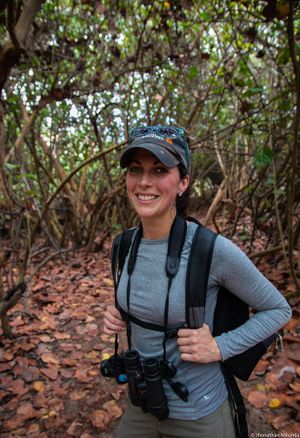NATIONAL ZOO AND CONSERVATION BIOLOGY INSTITUTE
Winging It: A Parenting Test for Guam Kingfishers
In April, the Smithsonian Conservation Biology Institute celebrated the birth of two extinct-in-the-wild Guam kingfisher chicks. Find out more about the new chicks in this update from animal keeper Erica Royer.
For the extinct-in-the-wild Guam kingfisher, the road to recovery has not been without complications. These territorial birds don’t always see eye to eye when breeding season comes around. With a population of around 135 individuals in human care, every bird is valuable — and every egg laid and chick hatched is another step closer to saving the species.
This month, we have two adorable reasons to celebrate! We shared in April that our newest and youngest Guam kingfisher pair, Animu and Giha, had two fertile eggs. On April 21 and 23, the chicks hatched! They have been keeping us very busy for the last several weeks.
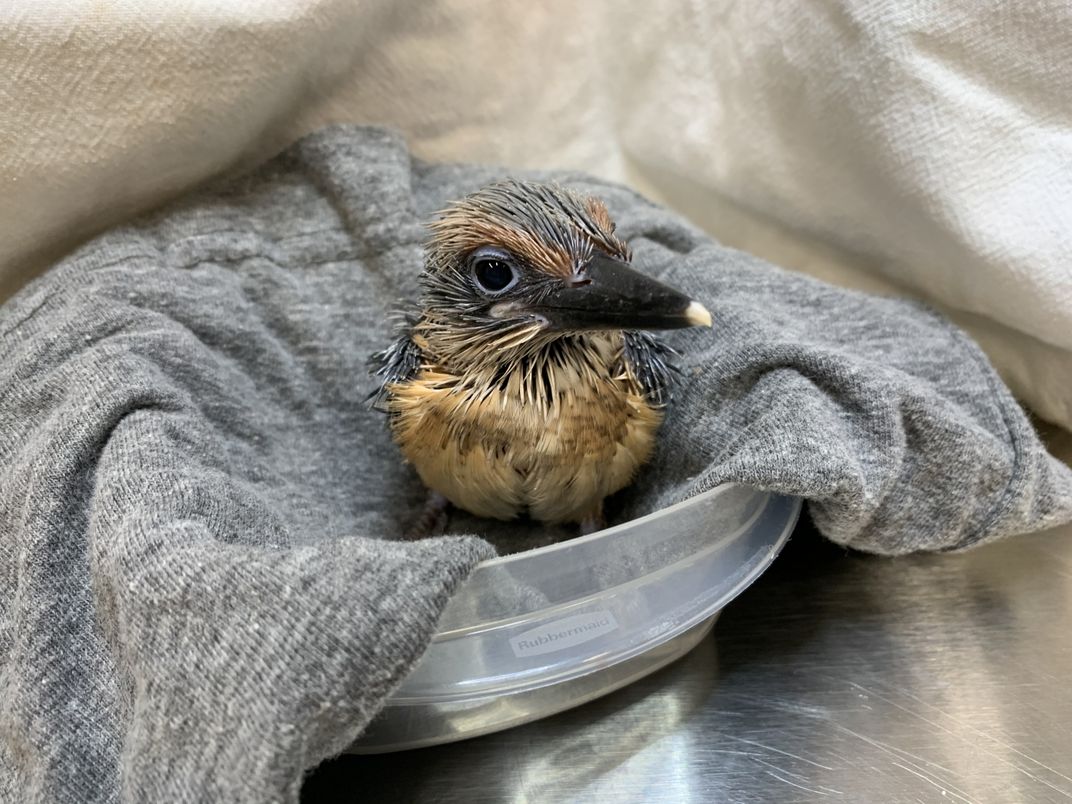
As first-time parents, we had concerns about Animu and Giha rearing two chicks on their own. We decided to hand-rear one chick to ensure its survival. On April 21, we checked the nest to find that the first of the chicks (a female) had hatched. We hoped to leave the first chick with its parents and hand-raise the second. Animu and Giha diligently incubated the chick and their second egg. After carefully observing the birds for two days, we noticed that they were not feeding the chick enough, despite appearing otherwise attentive. It’s not uncommon for new parents (of many different species!) to display poor parenting skills with their first offspring. But if a chick doesn’t get enough food, it can starve.
We had to decide whether to remove this first chick from the nest to care for it. Given the parents’ defensive behaviors toward keepers (including occasionally dive-bombing and shrieking at us) and their attentiveness to the nest, we decided to try something new. We would feed the chick every couple of hours inside the nest. This would give Animu and Giha a little more time to figure out that they needed to feed the tiny, squeaking, pink thing.
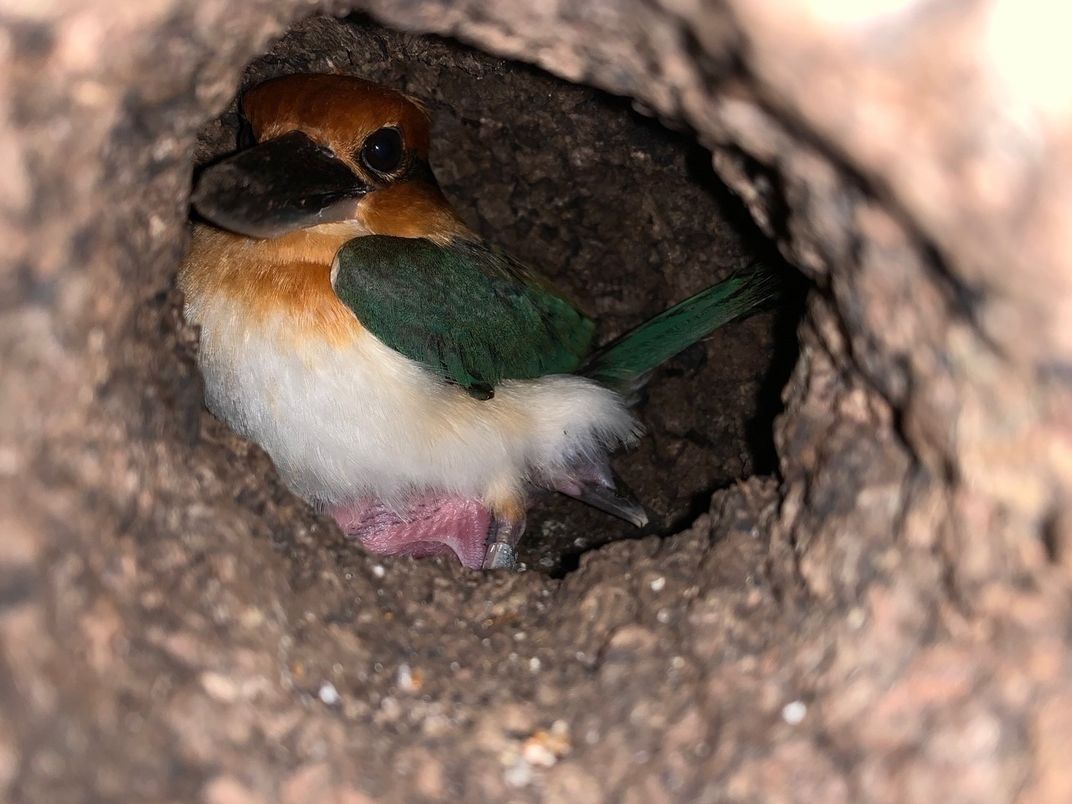
For two days, our team visited the chick every two hours. Guam kingfishers are carnivores, so we fed her moistened, chopped frozen mice. Most of these feedings occurred with Animu or Giha present in the nest. To our surprise, both parents were extremely tolerant of us offering food to the chick. The nest cavities that Guam kingfishers excavate are quite deep, which makes hand-feeding a chick this way difficult. So, we used bamboo skewers (and the help of a flashlight) to reach the chick’s mouth. After a couple of days, we saw the parents bringing food to the nest on their own, including some spiders and insects they found while foraging in their naturalistic enclosures. We even captured video of the birds feeding their chick throughout the night and into the early morning hours.
We gradually reduced our hand-feedings until the chick was 7 days old, and we were able to stop altogether. At that point, we weighed the chick to be certain that she was receiving enough food from her parents. She had made incredible weight gains, so we knew that Animu and Giha had figured out this parenting thing! We try to handle Guam kingfisher chicks as little as possible, but a weight check in the first few days and several days later was imperative to make sure she was on track to develop normally.
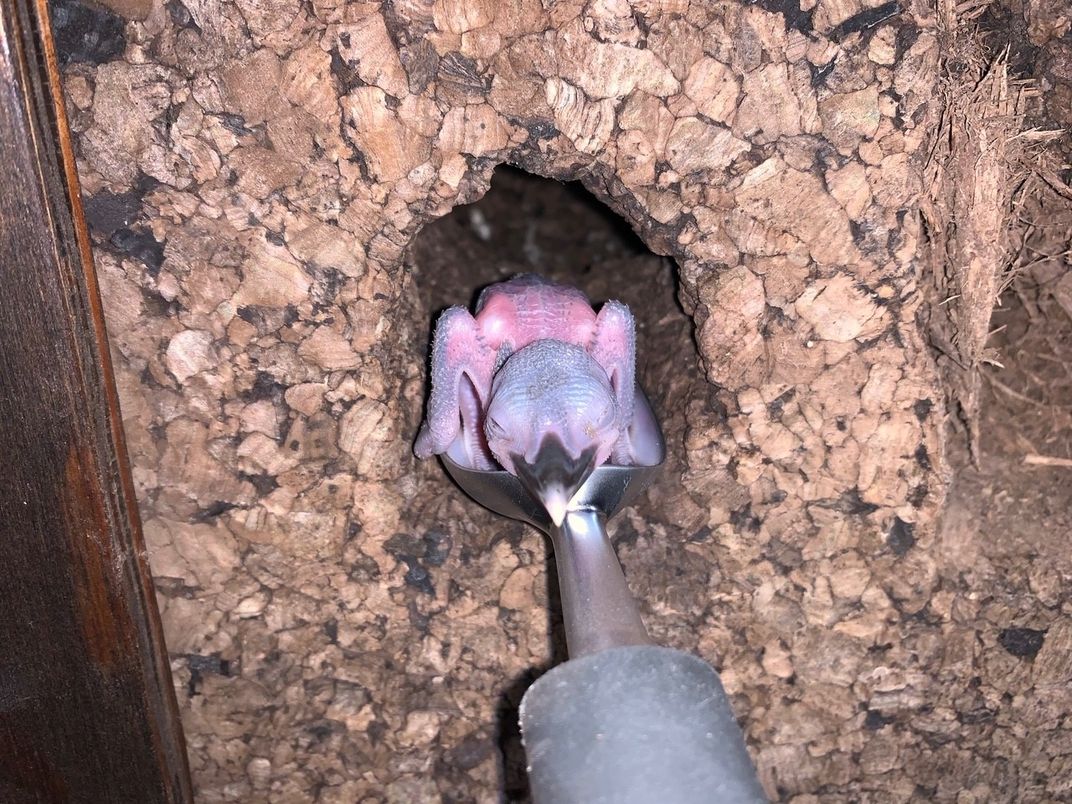
After Animu and Giha’s first chick hatched, their second egg pipped, which is when the embryo inside the egg uses the tip of its bill to start breaking through the shell. We moved this egg to an incubator, as planned, and monitored its progress throughout the day. On the morning of April 23, we were surprised to find that it still had not hatched.
Most baby birds cut around the large end of their shell, and then push against the newly weakened shell with both legs from inside the egg. In the process of cutting around the eggshell, Animu and Giha’s second chick had somehow pushed its right leg outside of the egg and was unable to break open the shell. It’s important not to assist a hatching egg unless absolutely necessary, because the chick inside needs time to finish absorbing the yolk sac. Assisting before a bird is ready to come out could be dangerous for the embryo.
However, after reviewing our incubator camera, it became clear that the chick had been trying to hatch from this position for several hours. We quickly cut away small portions of the shell to weaken it and allow the chick to continue hatching on its own. Tired and a little bit weak, the chick finally hatched within the hour and was sitting upright in no time!
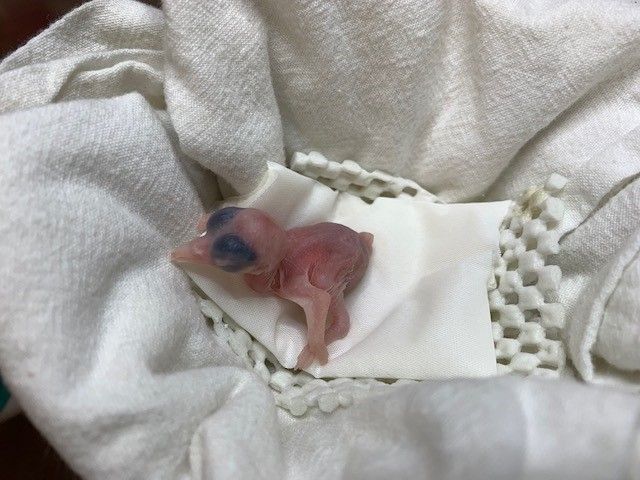
We are hand-rearing this male chick in our incubator room with as little exposure to people as possible. We play Guam kingfisher and other bird vocalizations during the day, and avoid speaking when working with him. After his eyes opened, we also placed mirrors in his incubator. When he and his sister fledge (leave the nest and become more independent) we will move him to a habitat near his sister, so he can socialize and learn appropriate kingfisher behaviors. The two may even share a habitat.
Video: The mirrors inside the chick’s incubator help limit his exposure to people. Instead of seeing us working in the incubator room, he sees his own reflection.
One of the interesting parts of hand-rearing is that it allows us to closely track and document the stages of Guam kingfisher development. We can use these milestones later when monitoring other chicks to make sure they are on track.
For example, how much do they weigh? When do their feathers start to develop, and which feathers develop first? When do their eyes open? When do they start vocalizing? And when do they start producing pellets or castings? Guam kingfishers (and many other species of birds, including hawks and owls) regurgitate, or throw up, a pellet of indigestible material when they finish eating. Pellets usually contain the bones, fur, teeth and/or insect exoskeletons of prey.
By about 2 weeks old, Guam kingfisher chicks have a lot to say. What starts out as a cute, squeaky vocalization when they are younger turns into a honking, raspy sound – especially when they are hungry or interacting with parents. Chicks are even a bit sassy during feedings, grabbing their food impatiently and biting at anything that comes within range.
Video: Listen to the raspy vocalizations Animu and Giha’s male chick makes when he is hungry.
The chicks eventually learn the variety of adult vocalizations that were once well-known in the forests of Guam for being so loud throughout the day and night. Chamorro people, the indigenous people of the Mariana Islands, have a legend of how the Guam kingfisher came to be. A village woman wore a blue dress, a white apron and an orange scarf around her head. One day, a taotaomo’na (a spirit of Chamorro ancestors) turned the woman into the first female kingfisher for making trouble. And after that, her loud cry could often be heard in the forest.
We are extremely pleased with how Animu and Giha have taken on their parenting responsibilities. In fact, this is the first time since 1985 that a Guam kingfisher pair at SCBI has successfully raised their own chick. We have a feeling it won’t be the last for this pair.
Not all our kingfishers have been as successful as Animu and Giha. In my last post, I also introduced you to our most genetically valuable pair, Fuetsa (fu-et-sah) and Kahåya (ka-ha-ja). We have been trying to introduce these two for breeding, but they have other ideas. They tend to bicker after a few days together, but still call for each other when separated. We reintroduced them after several weeks and were optimistic when Kahåya began spending a lot of time in her favorite nest cavity. This usually indicates that a female will soon lay eggs. Unfortunately, Kahåya laid her egg while perched on a branch, and the egg broke when it hit the ground.
We don’t know why she chose to lay her egg outside the nest, but this behavior has been seen before in the species. Luckily, Guam kingfishers can lay several clutches of eggs in a year. We hope she will lay an egg inside the nest cavity next time. For now, we set up makeshift “egg catchers” under her favorite perching spots. If she does lay another egg outside of the nest, it will hopefully have a softer place to land.
While some of our birds are not getting the hang of things yet, Animu and Giha continue to keep us busy. We noticed that Giha stopped feeding her chick after May 13 and only visited the nest once in the following days. This all made sense when we discovered that Giha had laid a new egg in a nest cavity in the pair’s larger enclosure. A second egg arrived May 18. Animu has taken over parental duties while Giha incubates her new eggs.
Video: In this video, Animu can be seen bringing a small lizard, called an anole, to his chick in the nest cavity.
Animu and Giha have turned out to be excellent parents, so we hope that continues and are monitoring their progress. Once the chick is independent, she can move to her own habitat and rejoin her brother. Stayed tuned to keep learning about our Guam kingfishers and whether more babies will soon be on the way!

